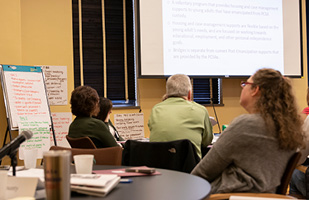Courts, Child Welfare Partners Coordinate Efforts regarding Foster Care

Staff at the Ohio Supreme Court share data to help courts and child welfare agencies implement best practices for foster care cases.

Staff at the Ohio Supreme Court share data to help courts and child welfare agencies implement best practices for foster care cases.
Every year, thousands of children in Ohio are impacted by the judicial system through no fault of their own. It’s a reality that compels courts and child welfare agencies to coordinate their efforts to ensure the safety and stability of such juveniles who end up in foster care.
On Thursday, representatives from across the state came to the Thomas J. Moyer Ohio Judicial Center to focus on abuse, neglect, and dependency dockets. The goal of the caseflow management course – hosted by the Ohio Supreme Court in conjunction with the Ohio Department of Job and Family Services and its Office of Families and Children – was to streamline practices with the goal of helping children find stable and permanent outcomes regarding where they live and who takes care of them as a guardian.
“I think, all too often, we get busy focusing on our own disciplines, even when we work in the same county. If we really want to make true progress and impact families and children, it takes days like this to come together, be collaborative, and be exposed to one another,” said Cynthia Scanland, the executive director of Allen County Children Services.
For the courts, their biggest obstacles revolve around notification and representation. Juvenile and family courts are required to notify all involved parties when it comes to custody hearings, and many times when unknown partners – typically fathers – can’t be reached or present during proceedings, continuances can drag a case on for months.
Another issue is access to justice. In smaller counties, there are few lawyers who practice in family law, and there are often multiple parties in need of representation.
“Many of these counties surround major metro areas,” said Veronica Burroughs, who’s the Court’s improvement program analyst. “They have problems finding attorneys, finding attorneys who will take this type of case, making sure attorneys are appointed timely.”
Since operations and standards for the courts and agencies aren't uniform across all 88 counties, staff at the Ohio Supreme Court concentrate on quantifiable outcomes to help courts implement best practices.“We really focus on data, so that they can start to look at data, and how to use data, and how to try to find important data points that they might want to improve on,” said Burroughs.
Along with the analyzation, implementation, and utilization of data as part of the daylong course, other parts of the curriculum included how the courts can help youth during difficult circumstances of transitioning to different homes and how the courts and child welfare agencies can prioritize potential issues.
“We did a similar program a few years ago, and found it to be very beneficial, because it enables us to step back and look for a minute where the impediments are and making these cases go more smoothly, more timely,” said Allen County Juvenile Court Judge Glen Derryberry.
As progressive or advanced as some groups may be with methodologies, those who’ve extensively worked in the field know there’s always a need to evolve and progress to keep up with societal shifts and developments in the legal landscape.
“We can’t let our statewide system or individual systems be static. They have to be fluid. So, in order for them to be fluid, we have to change,” said Scanland. “In order for them to change, we have to look at data, look at outcomes in order to make the changes that ultimately improve the lives of our community members.”


